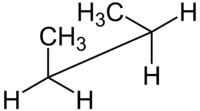Dihedral angle

A dihedral angle is the angle between two intersecting planes. In chemistry it is the angle between planes through two sets of three atoms, having two atoms in common. In solid geometry it is defined as the union of a line and two half-planes that have this line as a common edge. In higher dimension, a dihedral angle represents the angle between two hyperplanes.[1]
Definitions
A dihedral angle is an angle between two intersecting planes on a third plane perpendicular to the line of intersection.[2]
A torsion angle[3] is a particular example of a dihedral angle, used in stereochemistry to define the geometric relation of two parts of a molecule joined by a chemical bond.
Dihedral angles in stereochemistry
 |
 |
 |
| Configuration names | syn n-Butane Newman projection |
syn n-Butane sawhorse projection |

In stereochemistry every set of three (not co-linear) atoms of a molecule defines a plane. When two such planes intersect, the angle between them is a dihedral angle. Dihedral angles are used to specify the molecular conformation.[4] Stereochemical arrangements corresponding to angles between 0° and ±90° are called syn (s), those corresponding to angles between ±90° and 180° anti (a). Similarly, arrangements corresponding to angles between 30° and 150° or between -30° and -150° are called clinal (c) and those between 0° and ±30° or ±150° and 180° are called periplanar (p).
The two types of terms can be combined so as to define four ranges of angle; 0° to ±30° synperiplanar (sp); 30° to 90° and -30° to -90° synclinal (sc); 90° to 150°, and -90° to -150° anticlinal (ac); ±150° to 180° antiperiplanar (ap). The synperiplanar conformation is also known as the syn- or cis-conformation; antiperiplanar as anti or trans and synclinal as gauche or skew.
For example, with n-butane two planes can be specified in terms of the two central carbon atoms and either of the methyl cabon atoms. The syn-conformation shown above, with a dihedral angle of 60° is less stable than the anti- configuration with a dihedral angle of 180°.
For macromolecular usage the symbols T, C, G+, G-, A+ and A- are recommended (ap, sp, +sc, -sc, +ac and -ac respectively).
Dihedral angles of proteins

In a protein chain three dihedral angles are defined as φ (phi), ψ (psi) and ω (omega), as shown in the diagram. The planarity of the peptide bond usually restricts ω to be 180° (the typical trans case) or 0° (the rare cis case). The distance between the Cα atoms in the trans and cis isomers is approximately 3.8 and 2.9 Å, respectively. The cis isomer is mainly observed in Xaa-Pro peptide bonds (where Xaa is any amino acid).
The sidechain dihedral angles of proteins are denoted as χ1-χ5 for each successive bond along that chain. The χ1 dihedral angle is defined by atoms N-Cα-Cβ-Cγ, the χ2 dihedral angle is defined by atoms Cα-Cβ-Cγ-Cδ, and so on.
The sidechain dihedral angles tend to cluster near 180°, 60°, and −60°, which are called the trans, gauche+, and gauche− conformations. The stability of certain sidechain dihedral angles is affected by the neighbouring backbone and sidechain dihedrals; for example, the gauche+ conformation is rarely followed by the gauche+ conformation (and vice versa) because of the increased likelihood of atomic collisions.
Calculation of a dihedral angle
When the two intersecting planes are described in terms of Cartesian coordinates by the two equations
the dihedral angle,  between them is given by:
between them is given by:
An alternative method is to calculate the angle between the vectors, and
and  , which are normal to the planes..
, which are normal to the planes..
where  is the dot product of the vectors and
is the dot product of the vectors and  is the product of their lengths.
is the product of their lengths.
Any plane can also be described by two non-collinear vectors lying in that plane; taking their cross product yields a normal vector to the plane. Thus, a dihedral angle can be defined by three vectors,  ,
,  and
and  , forming two pairs of non-collinear vectors.
[5]
, forming two pairs of non-collinear vectors.
[5]
Dihedral angles in polyhedra
Every polyhedron, regular and irregular, convex and concave, has a dihedral angle at every edge.
A dihedral angle (also called the face angle) is the internal angle at which two adjacent faces meet. An angle of zero degrees means the face normal vectors are antiparallel and the faces overlap each other (Implying part of a degenerate polyhedron). An angle of 180 degrees means the faces are parallel (like a tiling). An angle greater than 180 exists on concave portions of a polyhedron.
Every dihedral angle in an edge-transitive polyhedron has the same value. This includes the 5 Platonic solids, the 4 Kepler–Poinsot polyhedra, the two quasiregular solids, and two quasiregular dual solids.
Given 3 faces of a polyhedron which meet at a common vertex P and have edges edges AP , BP and CP, the dihedral angle between the faces containing APC and BPC is:[6]
References
- ↑ Olshevsky, George, Dihedral angle at Glossary for Hyperspace.
- ↑ IUPAC gold book http://goldbook.iupac.org/D01730.html
- ↑ IUPAC gold book http://goldbook.iupac.org/T06406.html
- ↑ Anslyn, Eric; Dennis Dougherty (2006). Modern Physical Organic Chemistry. University Science. p. 95. ISBN 978-1891389313.
- ↑ Blondel, Arnaud; Karplus, Martin (7 Dec 1998). "New formulation for derivatives of torsion angles and improper torsion angles in molecular mechanics: Elimination of singularities". Journal of Computational Chemistry 17 (9): 1132–1141. doi:10.1002/(SICI)1096-987X(19960715)17:9<1132::AID-JCC5>3.0.CO;2-T.
- ↑ "dihedral angle calculator polyhedron". www.had2know.com. Retrieved 25 October 2015.
External links
- The Dihedral Angle in Woodworking at Tips.FM
- Analysis of the 5 Regular Polyhedra gives a step-by-step derivation of these exact values.




![\varphi = \operatorname{atan2} \left( \left([\mathbf{b}_1 \times \mathbf{b}_2]\times [\mathbf{b}_2 \times \mathbf{b}_3]\right) \cdot \frac{\mathbf{b}_2}{|\mathbf{b}_2|}, [\mathbf{b}_1 \times \mathbf{b}_2] \cdot [\mathbf{b}_2 \times \mathbf{b}_3] \right).](../I/m/42d30262c5209765eebba1a0fb04105e.png)
